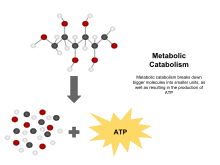

Catabolism (/kəˈtæbəlɪzəm/) is the set of metabolic pathways that breaks down molecules into smaller units that are either oxidized to release energy or used in other anabolic reactions.[1] Catabolism breaks down large molecules (such as polysaccharides, lipids, nucleic acids, and proteins) into smaller units (such as monosaccharides, fatty acids, nucleotides, and amino acids, respectively). Catabolism is the breaking-down aspect of metabolism, whereas anabolism is the building-up aspect.
Cells use the monomers released from breaking down polymers to either construct new polymer molecules or degrade the monomers further to simple waste products, releasing energy. Cellular wastes include lactic acid, acetic acid, carbon dioxide, ammonia, and urea. The formation of these wastes is usually an oxidation process involving a release of chemical free energy, some of which is lost as heat, but the rest of which is used to drive the synthesis of adenosine triphosphate (ATP). This molecule acts as a way for the cell to transfer the energy released by catabolism to the energy-requiring reactions that make up anabolism.
Catabolism is a destructive metabolism and anabolism is a constructive metabolism. Catabolism, therefore, provides the chemical energy necessary for the maintenance and growth of cells. Examples of catabolic processes include glycolysis, the citric acid cycle, the breakdown of muscle protein in order to use amino acids as substrates for gluconeogenesis, the breakdown of fat in adipose tissue to fatty acids, and oxidative deamination of neurotransmitters by monoamine oxidase.
YouTube Encyclopedic
-
1/3Views:701 43494 955474 641
-
Overview of metabolism: Anabolism and catabolism | Biomolecules | MCAT | Khan Academy
-
Metabolism, Anabolism, & Catabolism - Anabolic vs Catabolic Reactions
-
Concept of Metabolism (Catabolism and anabolism)
Transcription
Textbooks define metabolism, a topic in biochemistry, as a series of chemical reactions that take place inside of our bodies to sustain life. Now, this is a pretty broad definition of metabolism. So in this video, I really want to break this definition down to a more workable understanding of what metabolism really is. So first, I'm going to introduce another arrow in this diagram, like this, and say that really, the requirements of life, let's say in a human being, such as maintaining a constant internal temperature, reproducing, growing, and all that jazz, all of that ultimately boils down to the body's ability to utilize four essential biomolecules. And these four essential biomolecules, or as they're sometimes known as macromolecules, are proteins, fats, carbohydrates, or carbs, and nucleic acids, like DNA and RNA. And ultimately, all of these biomolecules perform different life-sustaining reactions inside of all of the cells in our body to ultimately promote life. So as you can see, we've already begun to break down this definition of metabolism. Essentially what we're saying here is that metabolism is really the study of how we're able to obtain these important biomolecules to sustain life. So how do we obtain these biomolecules? Now, a simple answer to this question is, of course, that we eat food to obtain all of these important biomolecules. But there is an important word of caution here, which is that since most food comes from living organisms like plants and animals, these plants and animals also contain an array of proteins, fats, carbohydrates, nucleic acids, but not necessarily in the same flavor or configuration that our bodies would prefer. So what do our bodies do instead? Well, in our bodies, we go ahead and eat the food. That's a very large head there, but you get the idea. And in our bodies, we break down this food through a process called digestion into the component parts of all of these biomolecules. So what do I mean by component parts? Well, the smallest subunit of proteins is called an amino acid. And our body breaks down all the different types of proteins that we digest into individual amino acids. And the same pattern continues for the rest of the biomolecules. So in the case of fats, we're talking about fatty acids, which are the smallest subunits of fats. And then for carbohydrates, which are long chains of sugars. One of the most common subunits of carbohydrates that our body loves is called glucose. So I'll go ahead and write that here, since you'll be seeing it a lot in the discussion of metabolism. And then finally, for nucleic acids were talking about nucleotides. So at this point, you're probably thinking, well, OK. I understand that our body can't use the same macromolecules found in food because maybe they're not in the right configuration. But how does breaking them down do anything for us? Now the key here is to recognize that in our body there is actually a delicate balance going on between the processes of breaking down molecules, such as in the process of digestion, and then taking these products and building them back up. So essentially, you can see all of these subunits, or monomers, as LEGO pieces that we're essentially reconstructing to build the right configurations of proteins, fats, carbs, and nucleic acids that our body needs. So that's really the key idea here, which is that metabolism is a balance between breaking things down and building them back up in our body so that we can customize, so to say, what type of macromolecules that we create. And just to throw in some vocab words, biochemists call the process of breaking down molecules in our body catabolism. And similar sounding word called anabolism is used to describe the process of building molecules back up. And the way I like to remember this is looking at the first letter of each of these words, I think of C, I think of cutting molecules up into tiny pieces, so breaking them down. And then for anabolism, A, I think of as like the apex of a building, for example. So we're building something up. Now this seems all fine and elegant, but there's one more issue that we need to contend with, which is a consequence of having to balance breaking things down and building them back up. And that is that this process of building molecules back up requires energy. Which I'm kind of indicating here by these yellow lightening bolt stars. So the question I want to answer in this last part of the video is where does this energy come from? Now, the answer to this question is that, well, we also get this energy by eating food. So how does that work? So first, recall that the energy currency of the cell-- and I'm going to go ahead and erase this just to give us some more space. The energy currency of our bodies is a molecule called ATP, or adenosine triphosphate. And this high energy molecule, as it's often referred to, when it is broken down into ADP, so it loses a phosphate group, it releases usable chemical energy that can fuel energy requiring processes in our body, such as the building up process of anabolism. Now, in order for this process to continue non-stop in our bodies, ADP must be regenerated into ATP. And that is where food comes in. So remember that we digest our food into all of these subunits. And some of these subunits, such as glucose and fatty acids mainly, but occasionally amino acids-- I'm going to put that in parentheses-- can essentially be used as fuels in our body. So just like wood, for example, is a fuel for a burning fire, which produces heat, these fuels in our body can essentially be broken down even further to produce the energy that's necessary to convert ADP back into ATP and thus allowing this cycle to continue. And just to throw in another vocabulary word that you'll probably see, this process of taking these fuels, which I've indicated with this asterisk, and breaking them down into usable energy is a process that's referred to as cellular respiration. And recall that because cellular respiration involves breaking down things even further, it's also a catabolic process. So it falls under this category of catabolism. And just to tie everything here together at the end, notice here that another way to interpret this cycling between ATP and ADP is to say that catabolism fuels anabolism. So what do I mean by this? Well, essentially, catabolism, such as the process of breaking things down and extracting energy through processes of cellular respiration, is coupled with this process of building things back up. And so in essence, one relies on the other. And as you can probably guess, these processes are really tightly regulated in our bodies. Because obviously you wouldn't want to be breaking down something while you're building something back up. And in fact, just to give you a preview forward, catabolism and anabolism are often regulated, so controlled, through the use of hormones. So I'm going to write here that hormones are a form of regulation, and tell the body whether it should be in a catabolic or anabolic state.
Catabolic hormones
There are many signals that control catabolism. Most of the known signals are hormones and the molecules involved in metabolism itself. Endocrinologists have traditionally classified many of the hormones as anabolic or catabolic, depending on which part of metabolism they stimulate. The so-called classic catabolic hormones known since the early 20th century are cortisol, glucagon, and adrenaline (and other catecholamines). In recent decades, many more hormones with at least some catabolic effects have been discovered, including cytokines, orexin (known as hypocretin), and melatonin.[citation needed]
| Hormone | Function[2] |
|---|---|
| Cortisol | Released from the adrenal gland in response to stress; its main role is to increase blood glucose levels by gluconeogenesis. |
| Glucagon | Released from alpha cells in the pancreas either when starving or when the body needs to generate additional energy; it stimulates the breakdown of glycogen in the liver to increase blood glucose levels; its effect is the opposite of insulin; glucagon and insulin are a part of a negative-feedback system that stabilizes blood glucose levels. |
| Adrenaline | Released in response to the activation of the sympathetic nervous system; increases heart rate and heart contractility, constricts blood vessels, is a bronchodilator that opens (dilates) the bronchi of the lungs to increase air volume in the lungs, and stimulates gluconeogenesis. |
Etymology
The word catabolism is from Neo-Latin, which got the roots from Greek: κάτω kato, "downward" and βάλλειν ballein, "to throw".
See also
- Autophagy
- Dehydration synthesis
- Hydrolysis
- Nocturnal post absorptive catabolism
- Psilacetin § Pharmacology
- Sarcopenia
References
- ^ de Bolster, M.W.G. (1997). "Glossary of Terms Used in Bioinorganic Chemistry: Catabolism". International Union of Pure and Applied Chemistry. Archived from the original on 2017-01-21. Retrieved 2007-10-30.
- ^
 This article incorporates text available under the CC BY 4.0 license. Betts, J Gordon; Desaix, Peter; Johnson, Eddie; Johnson, Jody E; Korol, Oksana; Kruse, Dean; Poe, Brandon; Wise, James; Womble, Mark D; Young, Kelly A (June 8, 2023). Anatomy & Physiology. Houston: OpenStax CNX. 24.1 Overview of metabolic reactions. ISBN 978-1-947172-04-3.
This article incorporates text available under the CC BY 4.0 license. Betts, J Gordon; Desaix, Peter; Johnson, Eddie; Johnson, Jody E; Korol, Oksana; Kruse, Dean; Poe, Brandon; Wise, James; Womble, Mark D; Young, Kelly A (June 8, 2023). Anatomy & Physiology. Houston: OpenStax CNX. 24.1 Overview of metabolic reactions. ISBN 978-1-947172-04-3.
External links
 Media related to Catabolism at Wikimedia Commons
Media related to Catabolism at Wikimedia Commons

